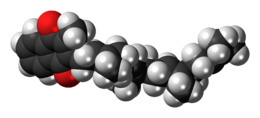 | |
 | |
| Clinical data | |
|---|---|
| Other names | 3-methyl-2-[(2Z,6E,10E)-3,7,11,15-tetramethylhexadeca-2,6,10,14-tetraenyl]naphthalene-1,4-dione |
| AHFS/Drugs.com | International Drug Names |
| Routes of administration | By mouth |
| ATC code | |
| Pharmacokinetic data | |
| Bioavailability | Low (oral)[1] |
| Identifiers | |
| |
| CAS Number | |
| PubChem CID | |
| ChemSpider | |
| UNII | |
| KEGG | |
| ChEBI | |
| CompTox Dashboard (EPA) | |
| Chemical and physical data | |
| Formula | C31H40O2 |
| Molar mass | 444.659 g·mol−1 |
| 3D model (JSmol) | |
| |
| |
| | |
Menatetrenone (INN), also known as menaquinone-4 (MK-4), is one of the nine forms of vitamin K2.
YouTube Encyclopedic
-
1/5Views:3189852 23550879 524
-
Menatetrenone Meaning
-
Menaquinone Meaning
-
Vitamin K2 MK-4 vs. MK-7 and Remineralizing Toothpaste
-
Bone Health: Maintaining Healthy Bones for Life
-
K2 Inhibits Vascular and Joint Calcification
Transcription
Biology
MK-4 is the major form of Vitamin K in vertebrate animals, including humans and common forms of meat animals. It is produced via conversion of vitamin K1 in the body, specifically in the testes, pancreas and arterial walls.[2] The conversion is not dependent on gut bacteria, occurring in germ-free rats[3][4] and in parenterally-administered K1 in rats.[5][6] Tissues that accumulate high amounts of MK-4 have a capacity to convert up to 90% of the available K1 into MK-4.[3][4][dubious ]
K1 is converted to MK-4 in three steps:[7]
- Removal of the phytyl tail to form menadione (K3; unknown enzyme);
- Reduction of menadione to menadiol (likely NQO1);
- Attachment of GGPP tail to form menaquinol-4, the reduced form of MK-4 (UBIAD1)
The second and third steps are known to happen in target tissue. The first step is proposed to happen mainly in the intestines.[7]
As a medication
Menatetrenone is approved in Japan for second-line treatment of postmenopausal osteoporosis. Evidence is restricted to small-scale RCTs; the minimum effective dose (for bone mass parameters) is 45 mg, much higher than the Daily Value for vitamin K (80 μg).[8]
Bioavailbility and dose
420 μg of oral MK-4, in a single-dose or spread out over 7 days, does not cause detectable changes in serum MK-4 level in healthy women, whereas MK-7 produces the expected increases in MK-7 levels.[1]
The minimum effective oral dose to change serum osteocalcin levels is 1500 μg/d, where as oral MK-7 is effective on this parameter at 45 μg/d, a level more in line with nutritional intake. In addition, rat studies show that oral MK-7 is better at increasing extrahepatic tissue levels of MK-4 than oral MK-4.[1]
References
- ^ a b c Sato T, Schurgers LJ, Uenishi K (November 2012). "Comparison of menaquinone-4 and menaquinone-7 bioavailability in healthy women". Nutrition Journal. 11 (93): 93. doi:10.1186/1475-2891-11-93. PMC 3502319. PMID 23140417.
- ^ Shearer MJ, Newman P (October 2008). "Metabolism and cell biology of vitamin K". Thrombosis and Haemostasis. 100 (4): 530–47. doi:10.1160/TH08-03-0147. PMID 18841274. S2CID 7743991.
- ^ a b Davidson RT, Foley AL, Engelke JA, Suttie JW (February 1998). "Conversion of dietary phylloquinone to tissue menaquinone-4 in rats is not dependent on gut bacteria". The Journal of Nutrition. 128 (2): 220–3. doi:10.1093/jn/128.2.220. PMID 9446847.
- ^ a b Ronden JE, Drittij-Reijnders MJ, Vermeer C, Thijssen HH (January 1998). "Intestinal flora is not an intermediate in the phylloquinone-menaquinone-4 conversion in the rat". Biochimica et Biophysica Acta (BBA) - General Subjects. 1379 (1): 69–75. doi:10.1016/S0304-4165(97)00089-5. PMID 9468334.
- ^ Thijssen HH, Drittij-Reijnders MJ (September 1994). "Vitamin K distribution in rat tissues: dietary phylloquinone is a source of tissue menaquinone-4". The British Journal of Nutrition. 72 (3): 415–25. doi:10.1079/BJN19940043. PMID 7947656.
- ^ Will BH, Usui Y, Suttie JW (December 1992). "Comparative metabolism and requirement of vitamin K in chicks and rats". The Journal of Nutrition. 122 (12): 2354–60. doi:10.1093/jn/122.12.2354. PMID 1453219.
- ^ a b Shearer MJ, Newman P (March 2014). "Recent trends in the metabolism and cell biology of vitamin K with special reference to vitamin K cycling and MK-4 biosynthesis". Journal of Lipid Research. 55 (3): 345–362. doi:10.1194/jlr.R045559. PMC 3934721. PMID 24489112.
- ^ Iwamoto J (May 2014). "Vitamin K2 therapy for postmenopausal osteoporosis". Nutrients. 6 (5): 1971–80. doi:10.3390/nu6051971. PMC 4042573. PMID 24841104.
administered daily doses of 15, 45, 90, and 135 mg revealed that 45 mg was the minimum effective dose for improving bone mass parameters evaluated by microdensitometry and/or single photon absorptiometry in postmenopausal women with osteoporosis
